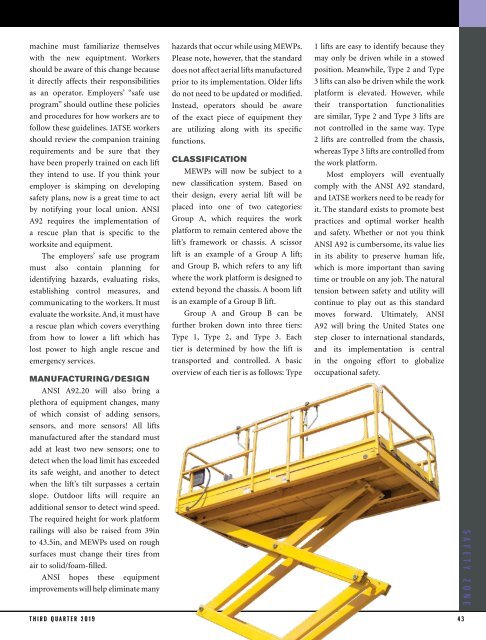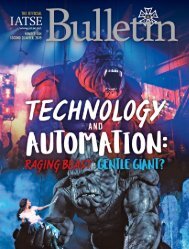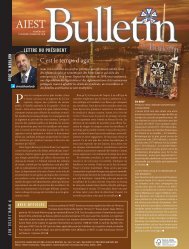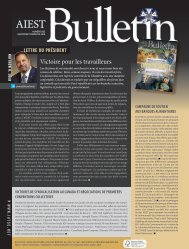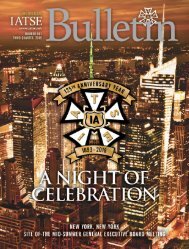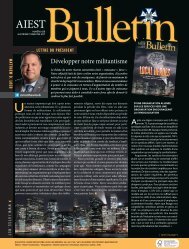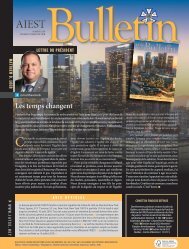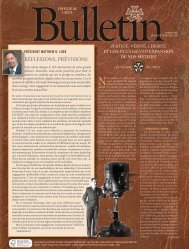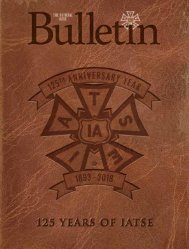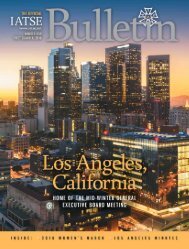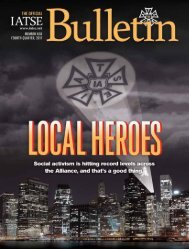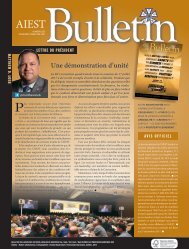IATSE 3rd 2019_web
Create successful ePaper yourself
Turn your PDF publications into a flip-book with our unique Google optimized e-Paper software.
machine must familiarize themselves<br />
with the new equiptment. Workers<br />
should be aware of this change because<br />
it directly affects their responsibilities<br />
as an operator. Employers’ “safe use<br />
program” should outline these policies<br />
and procedures for how workers are to<br />
follow these guidelines. <strong>IATSE</strong> workers<br />
should review the companion training<br />
requirements and be sure that they<br />
have been properly trained on each lift<br />
they intend to use. If you think your<br />
employer is skimping on developing<br />
safety plans, now is a great time to act<br />
by notifying your local union. ANSI<br />
A92 requires the implementation of<br />
a rescue plan that is specific to the<br />
worksite and equipment.<br />
The employers’ safe use program<br />
must also contain planning for<br />
identifying hazards, evaluating risks,<br />
establishing control measures, and<br />
communicating to the workers. It must<br />
evaluate the worksite. And, it must have<br />
a rescue plan which covers everything<br />
from how to lower a lift which has<br />
lost power to high angle rescue and<br />
emergency services.<br />
MANUFACTURING/DESIGN<br />
ANSI A92.20 will also bring a<br />
plethora of equipment changes, many<br />
of which consist of adding sensors,<br />
sensors, and more sensors! All lifts<br />
manufactured after the standard must<br />
add at least two new sensors; one to<br />
detect when the load limit has exceeded<br />
its safe weight, and another to detect<br />
when the lift’s tilt surpasses a certain<br />
slope. Outdoor lifts will require an<br />
additional sensor to detect wind speed.<br />
The required height for work platform<br />
railings will also be raised from 39in<br />
to 43.5in, and MEWPs used on rough<br />
surfaces must change their tires from<br />
air to solid/foam-filled.<br />
ANSI hopes these equipment<br />
improvements will help eliminate many<br />
hazards that occur while using MEWPs.<br />
Please note, however, that the standard<br />
does not affect aerial lifts manufactured<br />
prior to its implementation. Older lifts<br />
do not need to be updated or modified.<br />
Instead, operators should be aware<br />
of the exact piece of equipment they<br />
are utilizing along with its specific<br />
functions.<br />
CLASSIFICATION<br />
MEWPs will now be subject to a<br />
new classification system. Based on<br />
their design, every aerial lift will be<br />
placed into one of two categories:<br />
Group A, which requires the work<br />
platform to remain centered above the<br />
lift’s framework or chassis. A scissor<br />
lift is an example of a Group A lift;<br />
and Group B, which refers to any lift<br />
where the work platform is designed to<br />
extend beyond the chassis. A boom lift<br />
is an example of a Group B lift.<br />
Group A and Group B can be<br />
further broken down into three tiers:<br />
Type 1, Type 2, and Type 3. Each<br />
tier is determined by how the lift is<br />
transported and controlled. A basic<br />
overview of each tier is as follows: Type<br />
1 lifts are easy to identify because they<br />
may only be driven while in a stowed<br />
position. Meanwhile, Type 2 and Type<br />
3 lifts can also be driven while the work<br />
platform is elevated. However, while<br />
their transportation functionalities<br />
are similar, Type 2 and Type 3 lifts are<br />
not controlled in the same way. Type<br />
2 lifts are controlled from the chassis,<br />
whereas Type 3 lifts are controlled from<br />
the work platform.<br />
Most employers will eventually<br />
comply with the ANSI A92 standard,<br />
and <strong>IATSE</strong> workers need to be ready for<br />
it. The standard exists to promote best<br />
practices and optimal worker health<br />
and safety. Whether or not you think<br />
ANSI A92 is cumbersome, its value lies<br />
in its ability to preserve human life,<br />
which is more important than saving<br />
time or trouble on any job. The natural<br />
tension between safety and utility will<br />
continue to play out as this standard<br />
moves forward. Ultimately, ANSI<br />
A92 will bring the United States one<br />
step closer to international standards,<br />
and its implementation is central<br />
in the ongoing effort to globalize<br />
occupational safety.<br />
SAFETY ZONE<br />
THIRD QUARTER <strong>2019</strong> 43


